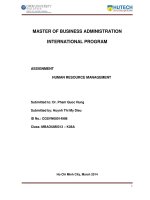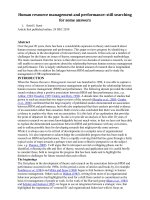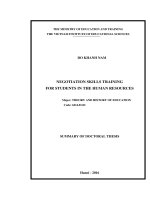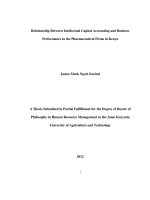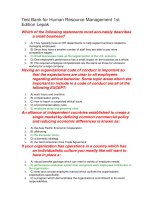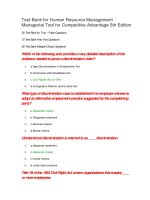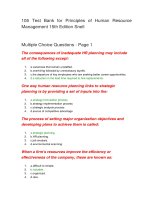Human resource management (eng, new, for student)
Bạn đang xem bản rút gọn của tài liệu. Xem và tải ngay bản đầy đủ của tài liệu tại đây (1.89 MB, 92 trang )
Bui Van Danh, PhD
Chap
Chap
Chap
Chap
Chap
Chap
Chap
Chap
1:
2:
3:
4:
5:
6:
7:
8:
HRM- Overview
HR Planning
Analyzing and Identifying Jobs
Recruiting
Orientation of Career
Training & Development
Performance Assessment
Compensation and benefits
HR
management is concerned with formal
systems in organizations to ensure the
effective and efficient use of human
talent to accomplish organizational goals
To enhance organizational performance,
HR management must be involved in
strategic plans and decision making,
participate in redesigning organizations
and work processes, and demonstrate
financial accountability for results
HR
management must perform three
roles: administrative, operational, and
strategic.
Expanding human capital requires HR
management to develop means to:
Attract human resources,
Develop their capabilities,
And retain human resources.
HR management activities can be grouped
as follows:
HR planning
Job analysis
Recruitment
Orientation of career
Training and development
Performance assessment
Compensation and benefits
Employee and labor/management relations.
HR challenges faced by managers and
organizations include:
Economic and technological changes
Workforce availability and quality
concerns
Demographics and diversity
And organizational restructuring.
(According to Workforce 2020, Hudson
Institute)
It
is important for HR management to be
a strategic business contributor in
organizations
Decentralization and outsourcing are
being utilized more frequently in the
management of HR units than they were
in past years.
Ethical behavior is crucial in HR
management, and a number of HR ethical
issues are regularly being faced by HR
professionals.
Some
diagnostic measures to check the
effectiveness of the HR function (Jac FitzEnz):
HR expense per employee
Compensation as a percent of expenses
HR department expense as a percent of
total expenses
Cost of hires
Turnover rate
Absence rate
Workers compensation cost per employee
Employee satisfaction (attitute survey), exit
interview
HR
planning involves analyzing and
identifying the future needs for and
availability of human resources for the
organization
Different organizational strategies require
different approaches to HR planning
The HR unit has major responsibilities in
HR planning, but managers must provide
supportive information and input.
When
developing HR plans, it is important for
managers to scan the external environment
to identify the effects of:
Assessment of internal strengths and
weaknesses as a part of HR planning requires
that current jobs and employee capabilities
be audited and organizational capabilities be
inventoried.
Individual employee demographics (age,
length of service in the organization, time in
present job)
Individual career progression (jobs held, time
in each job, promotions or other job
changes, pay rates)
Individual performance data (work
accomplishment, growth in skills)
Estimates
can be either top-down or
bottom-up, but essentially people who
are in a position to know are asked, “How
many people will you need next year?”
The Delphi technique uses input from a
group of experts.
The nominal group technique, unlike the
Delphi technique, requires experts to
meet face to face.
Statistical
regression analysis makes a
statistical comparison of past
relationships among various factors.
Simulation models are representations of
real situations in abstract form.
Productivity ratios calculate the average
number of units produced per employee.
Staffing ratios can be used to estimate
indirect labor.
Net
migration into and out of the area
Individuals entering and leaving the
workforce
Individuals graduating from schools and
colleges
Changing workforce composition and
patterns
Economic
forecasts for the next few years
Technological developments and shifts
Actions of competing employers
Government regulations and pressures
Factors affecting persons entering and
leaving the workforce
Downsizing is reducing the size of an
organizational workforce
Downsizing Approaches:
Attrition and hiring freezes
Early retirement buyouts
Layoffs occur when employees are put
on unpaid leaves of absence. If business
improves for the employer, then
employees can be called back to work.
Job:
A set of related duties
Job design: The process of defining the
way work will be performed and the tasks
that a given job requires
Job analysis: A systematic investigation of
the tasks, duties, and responsibilities
necessary to do a job.
The end products of job analysis are (1)
job descriptions, and (2) job
specifications.
Job Description
Job Specifications
A list
A list
of the tasks,
duties, and
responsibilities
(TDRs) that a
particular job entails
TDRs
are
observable actions
of the competencies
(knowledge, skills, and
abilities (KSAs) an
individual must have to
perform a particular job
Competencies
are
observed only when
individuals are carrying
out the TDRs of the job
Job
analysis information is useful in most HR
activities:
1.Planning
the job analysis
2.Preparing and
communicating
the job analysis
5.Maintaining
and updating
job descriptions
and
job specifications
3.Conducting
the job analysis
4.Developing
job descriptions
and job
specifications
